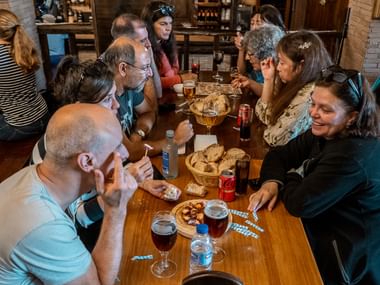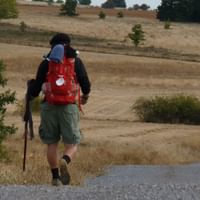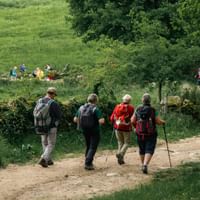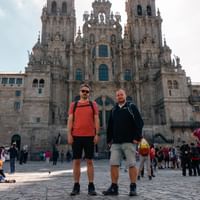Our Tours on the French Camino
Our Tours on the French Camino
The History of the French Camino
The route has existed for nearly a thousand years and has long been the main road for European pilgrims traveling to the tomb of the Apostle James in Santiago de Compostela. Along the way, churches, monasteries, bridges, and small villages emerged, welcoming travelers for centuries. The route is recognized by UNESCO as a World Heritage Site, and its significance for both believers and non-believers cannot be overstated. Today, the Camino Francés is a diverse experience where tradition and renewal meet, and where everyone – regardless of background – feels welcome.

Map of the French Camino
The French Camino is marked in red on the map.

The Route from France to Spain
The French Camino traditionally begins in the small French town of Saint-Jean-Pied-de-Port, close to the Spanish border. From there, the journey crosses the Pyrenees and continues into beautiful northern Spain. The route passes through regions such as Navarra, La Rioja, Castilla y León, and Galicia – each with its own character and charm. Along the way, you’ll encounter vineyards, wide open landscapes, small medieval towns, mountains, rolling green hills, and forests.
The Camino Francés is about 780 kilometers long, and the average pilgrim spends 4–6 weeks completing the full journey on foot. However, it’s also possible to walk just a portion of the route – for example, the final 100 kilometers from Sarria to Santiago de Compostela, which is enough to earn the official Compostela certificate.

Experiences and Encounters Along the Way
Along the journey, you’ll meet fellow walkers from all over the world. A special sense of community quickly forms on the trail, where everyone greets each other with the iconic “Buen Camino!”. Many pilgrims say that it’s not only the nature and history, but especially the people you meet along the way, that make the Camino such a unique experience.
The Camino is also rich in cultural highlights: the cathedrals in Pamplona, Burgos, and León, the historic bridge in Puente la Reina, local markets, small tapas bars, and cozy village inns. Everywhere you go, you’ll feel the Spanish hospitality and the joy of welcoming pilgrims.

We drive your luggage
On our walking holidays, we want you to focus on enjoying nature and the experiences along the way – without worrying about your luggage. That’s why we offer luggage carrying, making your walking holiday even more comfortable and hassle-free, allowing you to enjoy it to the fullest. Let us handle the logistics so you can focus on discovering new horizons, experiencing nature’s beauty, and creating memories for life. You can always contact us if you have further questions about the luggage service or find information on the specific holiday page.

Why Choose the French Camino?
Walking the Camino Francés is much more than just a long hike. It’s an opportunity to disconnect, challenge yourself, experience breathtaking landscapes, immerse yourself in Spanish culture, and create memories for a lifetime. Every day brings new views, experiences, and encounters – and no matter how far you choose to walk, you can look forward to a truly remarkable journey.

Use our app
On our self-guided walking and cycling holidays, you have access to our Bering Travel App. It can be used as a GPS during your trip, making it easy for you to follow the routes and stay on track.

Pilgrim passport on the Camino
You get your passport stamped in all the towns where you stay overnight and when you have enough stamps, you can get your pilgrimage certificate in Santiago de Compostela. Remember that you must have walked at least 100km on the Camino to get your pilgrimage pass.

Where Do Pilgrims Choose Extra Nights on the French Camino?
When walking the French Camino, many pilgrims decide to spend one or more extra nights along the way. This may be for rest, to explore interesting towns, or to experience more of the local culture and gastronomy. When you book your trip with Bering Travel, you can decide for yourself where – and if – you’d like extra nights during the journey.
Here are some of the most common places where pilgrims pause and enjoy an additional night:
1. Pamplona
Famous for its historic charm, old town, and the renowned San Fermín festival with running bulls. Many pilgrims stay an extra night to soak up the atmosphere and visit the city’s sights.
2. Logroño
Capital of La Rioja, Spain’s famous wine region. The city has a lively tapas culture, and many choose to stay here to enjoy wine tastings and the vibrant city life.
3. Burgos
Home to one of the Camino’s most beautiful cathedrals and a charming historic center. An extra night here offers time for sightseeing and relaxation.
4. León
A larger city with plenty of culture, excellent restaurants, and an impressive Gothic cathedral. Pilgrims often stop here to rest – and to enjoy some big-city atmosphere or shopping.
5. Astorga
Known for its Gaudí-designed Episcopal Palace and delicious chocolate. With its cozy vibe, Astorga is a popular place for an extra day.
6. Ponferrada
Here you can explore the well-preserved Templar castle. Ponferrada is a great spot for a rest day before heading into the more mountainous stages.
7. Sarria
The starting point for the final 100 km of the Camino, which many walk to earn the Compostela certificate. It’s often nice to arrive a day early, spending an extra night to prepare mentally and physically for the journey’s end.
8. Santiago de Compostela
Upon reaching the goal, most choose at least one extra night in Santiago to celebrate their arrival, visit the cathedral, and explore the historic city.
Frequently Asked Questions about the French Camino

"We look forward to making your holiday dreams come true"



